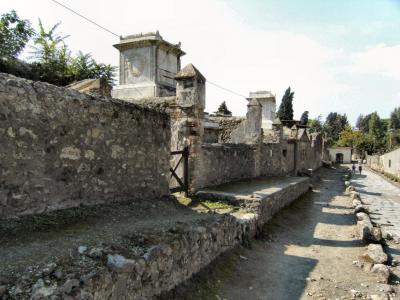The Street of Tombs, Pompei
Entering the city of Pompei one can't help noticing the row of tombs set along the road. Called the Street of Tombs, this cemetery stretches from the Herculaneum Gate along the road which leads towards Herculaneum, a nearby town, which, together with Pompeii, was destroyed by the eruption of Vesuvius in 79 AD.
The graves were placed here on purpose. Since it was forbidden to bury bodies inside the walls of Pompeii, this street outside the city, which, back in the day, was a busy road filled with travelers and lined with numerous shops, was chosen as a suitable burial ground.
It contains over 30 tombs, reflecting the wealth of those buried. The family of the deceased would sometimes have a meal at the tomb and pour a libation of wine, or blood, down a tube to the grave urn. This way the Romans believed the dead could share a meal with them.
The greater portion of the Street of Tombs was cleared in Spring 1813 under the “liberal patronage” of Napoleon’s sister, Caroline Murat, who was Queen of Naples during the French occupation of 1808-1815.
Passing through the picturesque plane balanced by the horizontally spread, light-filled ruins, cradled between the pastoral foreground and sleeping mountain at the back, this Street stands as a reminder that the entire city is a monument to the ancient Romans who perished here 2,000 years ago.
The graves were placed here on purpose. Since it was forbidden to bury bodies inside the walls of Pompeii, this street outside the city, which, back in the day, was a busy road filled with travelers and lined with numerous shops, was chosen as a suitable burial ground.
It contains over 30 tombs, reflecting the wealth of those buried. The family of the deceased would sometimes have a meal at the tomb and pour a libation of wine, or blood, down a tube to the grave urn. This way the Romans believed the dead could share a meal with them.
The greater portion of the Street of Tombs was cleared in Spring 1813 under the “liberal patronage” of Napoleon’s sister, Caroline Murat, who was Queen of Naples during the French occupation of 1808-1815.
Passing through the picturesque plane balanced by the horizontally spread, light-filled ruins, cradled between the pastoral foreground and sleeping mountain at the back, this Street stands as a reminder that the entire city is a monument to the ancient Romans who perished here 2,000 years ago.
Want to visit this sight? Check out these Self-Guided Walking Tours in Pompei. Alternatively, you can download the mobile app "GPSmyCity: Walks in 1K+ Cities" from Apple App Store or Google Play Store. The app turns your mobile device to a personal tour guide and it works offline, so no data plan is needed when traveling abroad.
The Street of Tombs on Map
Sight Name: The Street of Tombs
Sight Location: Pompei, Italy (See walking tours in Pompei)
Sight Type: Attraction/Landmark
Guide(s) Containing This Sight:
Sight Location: Pompei, Italy (See walking tours in Pompei)
Sight Type: Attraction/Landmark
Guide(s) Containing This Sight:
Walking Tours in Pompei, Italy
Create Your Own Walk in Pompei
Creating your own self-guided walk in Pompei is easy and fun. Choose the city attractions that you want to see and a walk route map will be created just for you. You can even set your hotel as the start point of the walk.
Pompeii Introduction Walk I
Modern-day Pompei is best known for its ancient predecessor, the Roman city of Pompeii, that fell victim to the massive eruption of Mount Vesuvius in 79 AD. The ruins of Pompeii, first uncovered in the late 18th century, were declared a World Heritage Site by UNESCO in 1997. Presently, this is one of the most popular tourist attractions in Italy, drawing annually up to 2.5 million visitors.
The... view more
Tour Duration: 2 Hour(s)
Travel Distance: 2.0 Km or 1.2 Miles
The... view more
Tour Duration: 2 Hour(s)
Travel Distance: 2.0 Km or 1.2 Miles
Pompeii Introduction Walk II
Frozen at the moment it was buried under the thick blanket of ash and pumice, the city of Pompeii (now excavated) remains a unique window into the past, offering a snapshot of everyday life back in the 1st century AD Roman Empire. Aside from causing quick and unexpected death to the city, the huge eruption of Vesuvius in 79 AD did have one positive outcome – it preserved everything (properties,... view more
Tour Duration: 3 Hour(s)
Travel Distance: 2.3 Km or 1.4 Miles
Tour Duration: 3 Hour(s)
Travel Distance: 2.3 Km or 1.4 Miles





